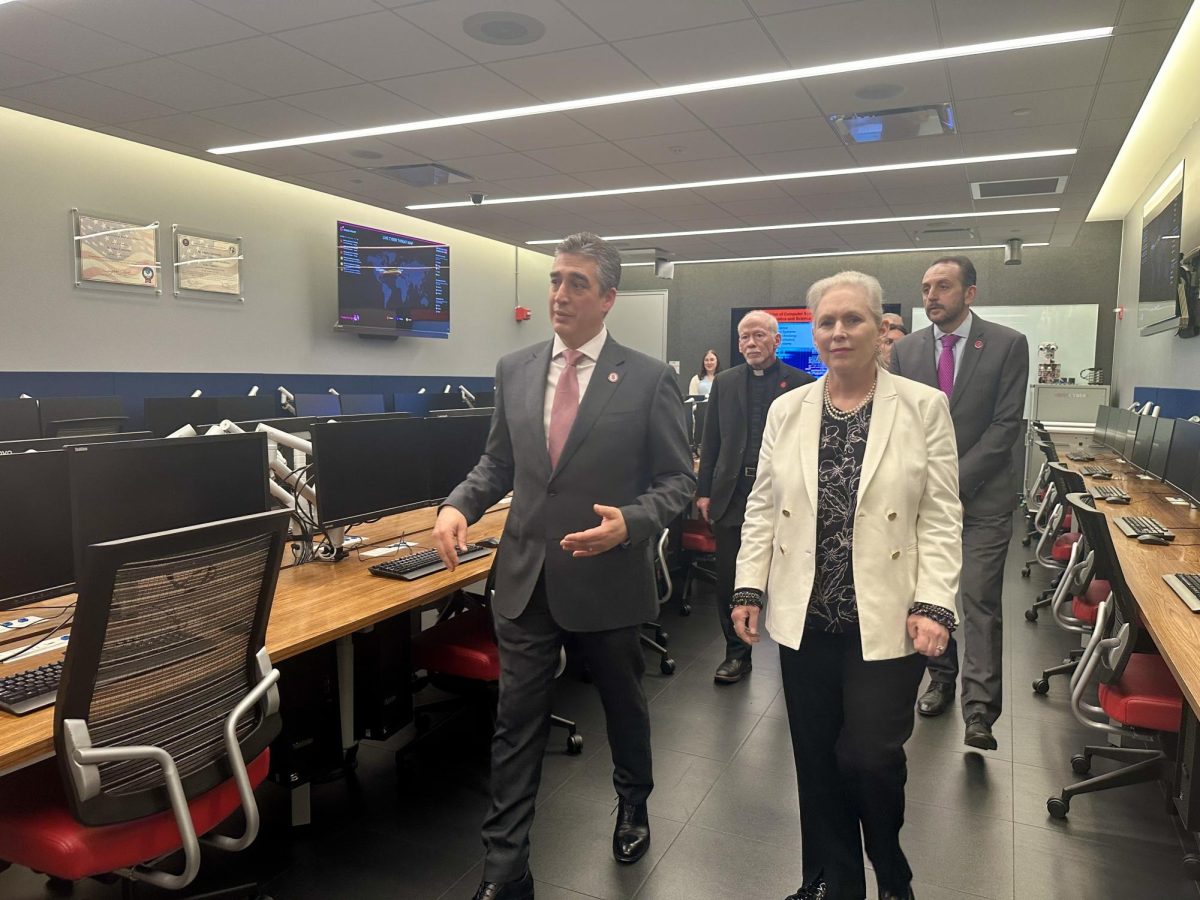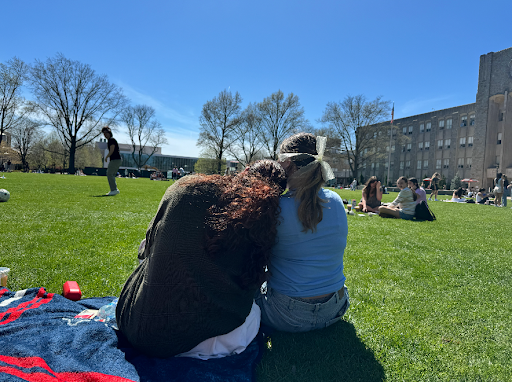It’s 3 p.m. – one of the busiest hours in the day on campus. Inside “the building with the flags”, various groups of students gather around tables with open books spread before them. Some are reading and writing; others are consulting their companions.
Further down, behind the glass door of a cubicle, a student is looking intently at a screen hanging on the wall. There’s seriousness, but no pressure, nor stress.
Occasionally, laughter is heard.
On February 21, the University opened a new language establishment, the Global Language and Culture Center, replacing the old-fashioned, computer-based language laboratory in St. Augustine’s Hall.
Like its predecessor, the GLCC offers Spanish, French, Italian, German, Hindi and English as a second language, and recently has added Arabic and Russian. And now, it will introduce Chinese and Portuguese, the latter of which will be offered as a new
course next semester.
“We want to build a culture of languages on campus – the modern world is global,” said Dr. Michele H. Jones, director of the center.
Indeed, this was the University’s aim when in 2009 it purchased 20,000 licenses of the language-learning software “Tell Me More.”
Yet, the center’s administration takes a radically different approach in this common goal. “Tell Me More” is still there, but it no longer plays the leading role. Rather, the center focuses on the human aspect of the language learning process.
“These days, students are constantly on computers, or cell phones”, said professor of Spanish and the administrative assistant of the GLCC, Katerina Trabazo. “They need a break.”
The center has removed the 39 computer stations from its language laboratory, leaving only nine. Thus, it hopes to help students learn languages in a “friendly and social” environment through individual tutoring sessions. Previously, students only had computers. Now, they have personal contact.
As tutors, students and administrators point out, there are many benefits of this unique, face-to-face learning process.
On a normal day, a student will come in and work with a tutor on vocabulary, pronunciation and comprehension. Instead of simply reviewing test corrections or tackling homework assignments, they may read a book aloud, or even hold a conversation.
“But, in the end, it’s all up to the student,” said Michael Eder, a junior French tutor.
At the GLCC, students can enjoy freedom and attention they often won’t be able to encounter in a class of 30 students.
Aside from class size, a greater problem that often hinders the students’ individual language improvement is shyness. Aware of their imperfections and fearful of embarrassing themselves in front of an entire class, students often opt not to ask their questions in class.
“They feel intimidated,” said Professor Trabazo.
But at the GLCC this is no longer a problem.
Twenty-five language tutors and four graduate assistants fall within St. John’s students’ age margins. These tutors are often volunteers – distinguished language students from within the University. Working on the details of one’s linguistic imperfections is easier in the company of peers, as opposed to the formal setting of a class with a professor. Not that the GLCC acts to substitute classes, however.
“We are a language support center,” said Trabazo.
Above all, they will get specific answers to their questions, not indirectly from a book or a computer.
“There are so many tutors able and willing to help that, eventually, you will get the solution – you won’t go out without it,” said freshman Lauren Smyth, one of the students who attends the center regularly.
“Plus, tutors aren’t computers. You will understand them.”
Several of the language courses offered at St. John’s require weekly sessions in the new language center as part of the course curriculum. Students spend an hour in the center. But even those who show less eagerness to attend, have a motivating factor. At the end of each appointment, the tutors send faculty individual reports on each student’s progress throughout the meeting.
“In this way, professors will get to know their students better – individually. They will no longer be a number. And, the professors will know they are making an effort,” said Eder.
To those who don’t like working one-on-one, the center also offers small group tutoring sessions and workshops.
“Confronting the challenges of a new language is always easier among peers. Everyone makes mistakes… it’s more friendly, and comfortable,” said the Spanish tutors, Alma Rodriguez, Bridget Cantelmo, and Mauricio Carrasco.
Some other services included are language classes “placement testing,” advisement on language courses and language minor curricular requirements.
Throughout the upcoming weeks, the Italian tutors have decided to hold final exam review sessions, thus acting as a genuine support center.
As of now, the GLCC receives approximately 1,000 students each month. Yet, as activities become refined and their numbers increase, Jones and Trabazo show confidence that even more students will come.
“We started from zero,” said Jones.
Trabazo explained that the center had limited resources. “Only in January, we had no books, no cable, nothing… just the Council Hall’s bare walls. It took us one month to complete the administrative
matters,” she said.
As the new language center is developing and its popularity is expanding, so is the list of the obstacles to surmount. The building is too small. There’s a need of space for placement testing, for which the GLCC is by no means well accommodated.
“It is too noisy and informal,” said Jones.
Yet, when asked whether the center expects any linguistic additions in the near future, Jones replied, “Not right now. That’s for the University’s educational policy committees to decide.”
As of now, the focus rests on the need of freedom to post more academic activities and the hope to create minors in Russian and Arabic.
In consideration of the fact that the centre opened just two months ago, for some it already acts as a cultural immersion center.
“You can’t separate culture from a language,” said Elisa Martellaccio, a graduate assistant and Italian tutor. “It’s the essential element.”
“Food and accent attract students to culture most. When you visit a country, you don’t talk to a computer,” said Carrasco.
Relationships between students and tutors are building. The Italian and Spanish tutors point out the number of students who will drop in to just say hello. Some will even stop them in the University’s hallways, consulting their linguistic concerns.
“This isn’t Madrid, Paris, Lisbon… or Rome,” highlights Trabazo, “but it’s the best we can offer the St. John’s community.”
“As long as tutors are passionate about it, we’ll keep going,” said Carrasco.
And so it is, with enthusiasm, the Global Language and Culture Center is already building a culture of languages at St. John’s.

















